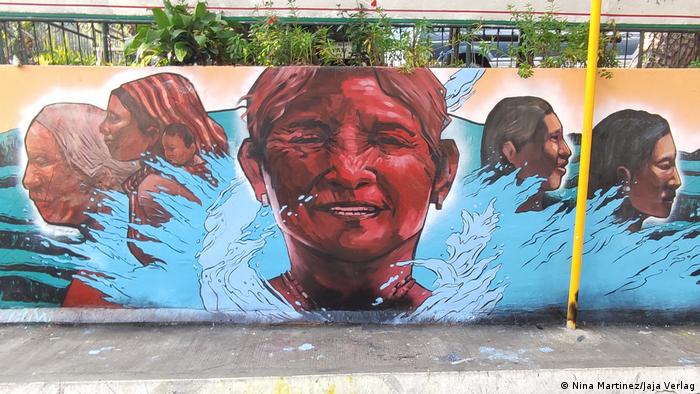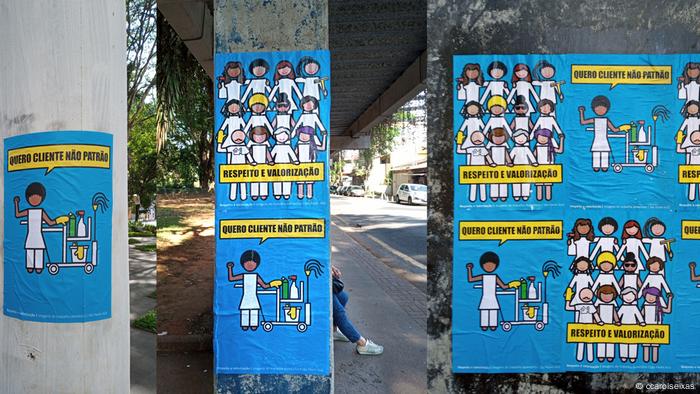Violence against women is a global problem. But women all over the world are successfully defending themselves. The Goethe-Institut shows how they fight for their rights at the festival “Frequenzen. Feminismen global”.

This mural features “Mother Tining” who is fighting to protect her community in the Philippines
“Protests and resistance do not necessarily follow the same pattern all over the world. Every country, every context offers its own motivators, its own catalysts,” explains Indian publisher Urvashi Butalia during the press conference for the Berlin festival “Frequencies. Feminisms global”. . “One thing that feminist protests around the world have in common, however, is the unique way in which feminists have developed their own forms of protest.”
Art as a Medium of Resistance
Butalia has been committed to women's rights and to giving a voice to discriminated ethnic groups in her home country for more than 40 years. The author and publicist was a co-founder of India's first feminist book publishing company and has been running her own publishing company since 2003. Together with the textile artist Aram Han Sifuentes and the Afghan artist Nabila Horakhsh, she will open the three-day festival on Thursday evening (May 19). Sifuentes designs protest banners and will also lead a workshop during the festival. With her colorful and meaningful pictures, Horakhsh rebels against the patriarchy in her country – in the last few months especially against the Taliban, which has regained strength and is trampling on the rights of women in Afghanistan.
View this post on Instagram
The interdisciplinary festival organized by the Goethe-Institut from 19.-21. May 2022 in Berlin, gives an insight into the connecting elements of feminist protest cultures around the world, but also wants to shed light on the individual contexts. “In our project, we talk about feminisms,” says Nadine Siegert, who has headed the Goethe-Institut in Lagos, Nigeria, since 2021. Especially with regard to the African continent with its more than 50 countries, it is important to speak in the plural, since the initial situations and thus also the protest movements in the respective states are very different.
“South Africa is very well known for its very progressive, very modern constitution,” Siegert continued during the press conference. “In the constitution of South Africa, not only women, but also groups such as the LGBTI community are granted many rights (…) Unfortunately, in reality it often looks very different.” Among other things, Siegert cites the frightening example of “corrective” rape: In South Africa, lesbian women in particular are at risk of being raped with the intention of “correcting” their sexual orientation. This is one of the reasons why, according to United Nations estimates, South Africa the country where the most women are raped in the world.
Siegert also points out that domestic violence against women has risen sharply during the tough lockdown in South African cities such as Johannesburg. The number of femicides – or femicides as the killing of women because of their gender is called in some countries – has also increased drastically worldwide.

In the workshop by Aram Han Sifuentes, participants will learn how to use applique techniques to create protest banners
The fact that sexualized violence is not a regional but a global problem will be discussed, among other things, during the discussion on “Femicides and violence against women” on May 20th. Two of the speakers, Hannah Beeck and Lujan Pinelo, started the online database Feminizidmap a few years ago, which documents the murder of women in Germany. Other speakers on this panel are the lawyer Valeria España, who deals with court decisions and criminal prosecution in various South American countries, and the Indian writer Meena Kandasamy, who writes in her texts about trauma and violence against women.
Feminism is not a “luxury concern”
Protest, resistance and the fight for more equality are not only issues being pushed by urban women, but they also affect women in rural areas, as the comic book series “Movements and Moments” addresses. Initiated by the Goethe-Institut Jakarta, this project presents 16 selected stories from 14 countries in the Global South. In addition to women's rights, it is also about ecological activism, climate change or the fight for education and the rights of LGBTIQA+ people.
At the project presentation on May 20, the speakers Faye Cura and Nina Martinez will present the comic “Let the river flow” (see article image). It is the true story of Leticia, nicknamed “Mother Tining”, a woman in her 70s from the Naneng tribe of Kalinga in the Cordillera region of the Philippines. She was protesting the construction of a World Bank-funded dam that would have flooded the village of Naneng and other villages in the surrounding provinces. The struggle of women and men against the “National Power Corporation” and the Philippine police forces lasted for more than 40 years. They defy violence, kidnapping and torture. The dam was not built due to persistent resistance. To this day, Mother Tining and other Indigenous activists continue to resist corporate and government actions that could harm the Chico River and surrounding areas.

Connecting is very important for women in their fight for more rights
The Fighting for more rights spans many generations, as the story of Mother Tining shows. Urvashi Butalia agrees: “These are women my age. We have gray hair. We've been around for so long that over the years we've learned not to let ourselves be overwhelmed [by the depression].” The festival “Frequenzen. Feminism Global” now gives over 50 activists from all over the world a platform in Berlin.
For anyone interested outside of Berlin, there is also the opportunity to digitally fight for women's rights to pursue. In Africa, for example, feminists are increasingly using the Internet to network. This is also shown, for example, by the websites for the “House of African Feminism” project, which the Goethe-Institut helped to design, which is also a theme at the festival